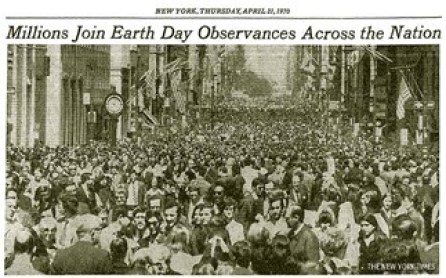This is an Eval Central archive copy, find the original at rka-learnwithus.com.
Whether or not public programs are again canceled because of the COVID-19 pandemic, Earth Day each April 22 warrants the engagement of the museum sector. Emlyn Koster explains why.
“Earth Day 1970 gave a voice to an emerging public consciousness about the state of our planet — In the decades leading up to the first Earth Day, Americans were consuming vast amounts of leaded gas through massive and inefficient automobiles. Industry belched out smoke and sludge with little fear of the consequences from either the law or bad press. Air pollution was commonly accepted as the smell of prosperity. Until this point, mainstream America remained largely oblivious to environmental concerns and how a polluted environment threatens human health.”
–“The History of Earth Day,” from EARTHDAY.ORG

In 2005 the US National Academies determined that ‘climate change’ is preferable to ‘global warming’ because more than the atmosphere’s average temperature had been changing. News of governments tackling the ‘climate emergency’ is both pleasing and concerning. Pleasing that there is global communication although, as Greta Thunberg and her generation anxiously point out, today’s mitigating efforts run the perilous risk of being too little too late. In the 21st century, the world must grasp that climate and weather are interconnected with all other natural phenomena that encircle the Earth — oceans and rivers, ice sheets and glaciers, sea level, ecosystems, biodiversity, food chains, viruses, etc. — and that each has been, indeed continues to be, adversely impacted by human activities. Melting ice and rising sea level are, for example, more consequential than changing weather patterns. And while climates are being disrupted, oceans are being warmed and coral reefs are being bleached, the biosphere is being abruptly reduced by extinctions, plastic debris has become ubiquitous, and parts of the Earth’s crust have been impacted by waste disposal and hydraulic fracturing.
Society and the Anthropocene

Image via IASS Potsdam.
A scientific term joins mainstream conversation when it becomes helpful to communicate about a subject of rising interest and/or pressing importance. 2020 presented a compelling example: society quickly understood and used the terms pandemic and COVID-19. Although the natural history of the Earth is fascinating to many, Geologic Timescale terms have not become household words — with two exceptions. One is when Hollywood’s imagination of Jurassic Park became a blockbuster film (likely destined to remain unknown, though, is that it was field studies in the Jura Mountains along the France-Switzerland border by naturalist Alexandre Brongniart (1770-1847) that led to the term Jurassic for the period 200-146 million years ago). The second and much more consequential one is the Anthropocene (pronounced anthro-pocene like anthro-pology and of Greek origin with anthro referring to human and cene meaning a recent geological interval). For this one, we should know about Paul Crutzen (1933-2021), a Dutch meteorologist and atmospheric chemist who became a Nobel Laureate in 1995. In 2002, he contributed a seminal view to the journal Nature. Titled ‘Geology of Mankind’ it concluded: “A daunting task lies ahead for scientists and engineers to guide society towards environmentally sustainable management during the era of the Anthropocene”. Not only was it novel to imply that humanity is a geologic agent but his call to action for science and engineering to guide society was extraordinarily important.
No geologic timescale interval has previously been named in recognition of one species. This is certainly not an honor for us, Homo sapiens. Rather, it signals that humanity has, both carelessly and inadvertently, enabled a situation to rapidly develop that has imperiled all life, both human and non-human. Five years ago, science and environment journalist Andrew Revkin framed the Anthropocene as “common shorthand for this turbulent, momentous, unpredictable, hopeless, hopeful time — duration and scope unknown”. In 2017, environmental humanities scholar Christopher Schaberg wistfully asked: “Can the grand Anthropocene story, which highlights humanity as an exceptional actor in planetary morphology, help provoke a greater sense of human responsibility?”. Last year I defined the Anthropocene with a pragmatic recognition that humanity as the dominant species has extensively detached itself from the Earth System, endangering the future of both. A complicating matter is that the geological profession’s search for the best worldwide marker for the start of the Anthropocene — which currently looks likely to be the mid-20th century when atomic bomb testing left a distinctive chemical signature in lake deposits — is a different focus than the term’s relevance to the future state of the world.
Museums and the Anthropocene
Why has the museum sector hesitated to embrace this term? Is it because we must have a collection of related objects, or we lack fulsome knowledge, or we remain reticent to tackle contemporary subjects? The good news is that the tide has started to turn. Three Danish faculty have just documented 41 exhibitions since 2011 about the Anthropocene, almost 80% of which have been/are in art museums. And I have recently proposed in an upcoming Exhibition article how museums of all types have a more nimble and more immersive exhibition approach to consider.
Museums will hopefully find it feasible to emulate a reorientation described by historian David Christian: “Today’s scholarly world may be recovering the ancient balance between detailed and unifying knowledge. And doing that is increasingly urgent in a world that faces the colossal challenge of managing an entire planet, a challenge that cannot even be seen clearly through the narrow lenses of existing scholarly knowledge. The discipline-based scholarly world of the twentieth century generated much rich knowledge in so many fields that it should now be possible… to tackle the new problems of the Anthropocene with a rigor and richness, and a global scholarly reach, that was unthinkable before the twenty first century”.
To strive for unified knowledge about nature and culture, with equal respect for both, would be a profound goal of the museum sector. Biodiversity and diversity — respectively referring to the millions of animal and plant species and to just us — are each common terms yet they are unhelpfully disconnected in our conscience: it was only a geological nanosecond ago that human life evolved away from being an integral element of wildlife. Focused on the disconnects between nature and culture, the Alliance of World Scientists has nearly 26,000 signatories from almost 200 countries. Conversations about climate change in isolation oversimplify the whole Earth System scale of challenges facing us in the Anthropocene. The last annual report of Human Rights Watch highlights the link between climate change and pandemics. The choice of existential by dictionary.com as the word of the year in 2019 concluded: “It’s the threat of ceasing to exist that worries people now”. We can therefore see — surely we must see — that an ecological one-Earth perspective has become critical.
About the Author
Emlyn Koster, PhD ([email protected]) is a former CEO of Canada’s Royal Tyrrell Museum of Paleontology and Ontario Science Centre, New Jersey’s Liberty Science Center, and the NC Museum of Natural Sciences. Widely published, he has also been a board chair of the Geological Association of Canada. Currently, he is an ambassador for the International Coalition of Sites of Conscience and an adjunct professor in Marine, Earth and Atmospheric Sciences at NC State University. For Earth Day 2021, he is a panelist at a Johns Hopkins University forum titled ‘Environmentalism Today’; organized by Museum Studies, others include the lead senior scientist at the Environmental Defense Fund and project director at the Center for Scientific Evidence in Public Issues at the American Association for the Advancement of Science.
Emlyn is a guest blogger for RK&A in 2021. From his vantage point as a geoscientist, museologist, and humanist, Emlyn will explore difficult topics of our time through a monthly series of op-ed style blog posts called “Relevance Revisited,” imploring museums to be leaders in addressing these issues. Read Emlyn’s previous posts here.
The post Earth Day at 51: Why Museums Must Embrace the Anthropocene appeared first on RK&A.